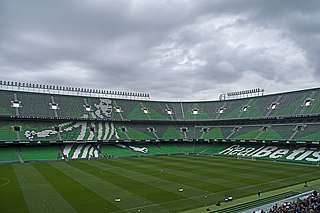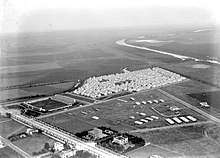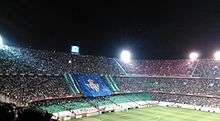Estadio Benito Villamarín
Estadio Benito Villamarín is a stadium in Seville, Spain, and the home of Real Betis since its completion in 1929. With a capacity of 60,720, it is the 4th-largest stadium in Spain and the largest in Andalusia.[2]
 | |
| Full name | Estadio Benito Villamarín |
|---|---|
| Former names | Estadio Heliópolis (1939–1961) Estadio Manuel Ruiz de Lopera (1997–2010) |
| Location | Avenida de Heliópolis, s/n 41012 Seville |
| Coordinates | 37°21′23″N 5°58′53″W |
| Owner | Real Betis |
| Operator | Real Betis |
| Capacity | 60,720[1] |
| Record attendance | 57,123 (Real Betis v Valencia; 7 February 2019) |
| Construction | |
| Opened | 1929 |
| Expanded | 1982, 2000, 2017 |
| Tenants | |
| Real Betis (1929–present) Spain national football team (selected matches) | |
History
Construction
As early as 1912, the Spanish architect Aníbal González Álvarez-Ossorio had an initial design of a stadium for the Ibero-American Exposition of 1929. The executive committee has commissioned the architect Antonio Illanes del Río to complete the design in 1923.[3] Several locations were considered for the new stadium when finally the current location was chosen by commissar Cruz Conde.[3] The technical study for its construction was carried out by Manuel María Smith who has designed the San Mamés Stadium of Bilbao in 1913.[3] The construction works were launched in 1923 and finally completed by the end of 1928.[3]
Inauguration

The newly-built Estadio de la Exposición was officially inaugurated on March 17, 1929, hosting an international match where Spain defeated Portugal 5-0, after being blessed by Archbishop Eustaquio Ilundáin y Esteban of the Roman Catholic Archdiocese of Seville.
After the end of the exhibition in 1930, the venue remained as a municipal property, although Real Betis began to play their home matches on a regular basis. On July 16, 1936, the Real Betis had finally gained the lease of the stadium and became its sole tenant.
During the Spanish Civil War, the Seville City Council requisitioned the stadium and handed it over to the military command, which assigned it to various uses, including as base camp for the Moroccan troops, as a headquarter for the Italian General Staff who carried out some works inside the stadium to adapt it to their needs, and as a headquarter of the mechanized cavalry unit.
The stadium had suffered major damages as a result of the war. After the war, Real Betis has agreed with the military authorities to restore the stadium. The renovation was carried out with the help of Gonzalo Queipo de Llano. The stadium was reopened on March 12, 1939, bearing the name of Estadio Municipal Heliopolis.
After the Benito Villamarín era
In 1958, the extension of the northern and southern stands was carried out by the architect Antonio Delgado y Roig. In 1959 electric lighting was installed with 4 towers of 48 spotlights each.
On August 12, 1961, the stadium became owned property by Real Betis. Few days later, the stadium was renamed after Benito Villamarín who served as the club president between 1955 and 1965. The stadium was blessed by Cardinal José Bueno y Monreal.
Between 1971 and 1973, the northern and southern stands were entirely demolished to be rebuilt. With continuous expansion works during the 1970s, the capacity of the stadium was increased up to 48,500 spectators. However, major renovation works were carried out between 1979 and 1982 for the 1982 FIFA World Cup and the capacity of the stadium was increased up to 50,253. The stadium hosted 2 group matches during the tournament.[4]
Current status


In 1997, the stadium was renamed after the then-club president Manuel Ruiz de Lopera. However in 2010, Real Betis fans voted to change the name of the stadium back to honor former club president Benito Villamarín.[5]
In 2016, the southern stand of the stadium was demolished for expansion. After the most recent redevelopments, the total capacity of the stadium was increased from 52,000 to 60,720.[1] The expansion work was completed in August 2017 in time for the 2017–18 La Liga season.[6]
International matches
Spain national team matches
| Date | Opponent | Score | Competition |
|---|---|---|---|
| 17 March 1929 | 5–0 | Friendly match | |
| 21 December 1983 | 12–1 | UEFA Euro 1984 qualifying | |
| 17 October 1984 | 3–0 | 1986 FIFA World Cup qualification | |
| 25 September 1985 | 2–1 | 1986 FIFA World Cup qualification | |
| 12 November 1986 | 1–0 | UEFA Euro 1988 qualifying | |
| 18 November 1987 | 5–0 | UEFA Euro 1988 qualifying | |
| 16 November 1988 | 2–0 | 1990 FIFA World Cup qualification | |
| 23 March 1989 | 4–0 | 1990 FIFA World Cup qualification | |
| 10 October 1990 | 2–1 | UEFA Euro 1992 qualifying | |
| 12 October 1991 | 1–2 | UEFA Euro 1992 qualifying | |
| 22 April 1992 | 3–0 | 1994 FIFA World Cup qualification | |
| 24 February 1993 | 5–0 | 1994 FIFA World Cup qualification | |
| 28 April 1993 | 3–1 | 1994 FIFA World Cup qualification | |
| 7 June 1995 | 1–0 | UEFA Euro 1996 qualifying | |
| 15 October 2018 | 2–3 | 2018–19 UEFA Nations League |
1982 FIFA World Cup
The stadium hosted two group matches in the 1982 FIFA World Cup. The other Group 6 games were held at Pizjuán, Seville and La Rosaleda, Málaga.[7]
| Date | Team #1 | Res. | Team #2 | Round | Attendance |
|---|---|---|---|---|---|
| 18 June 1982 | 4–1 | Group 6 | 47,379 | ||
| 23 June 1982 | 4–0 | Group 6 | 43,000 |
Gallery
 Estadio Benito Villamarín in 2014
Estadio Benito Villamarín in 2014 Exterior of the stadium in 2014
Exterior of the stadium in 2014 Interior of the stadium in 2014
Interior of the stadium in 2014 Real Betis vs Villarreal in 2018
Real Betis vs Villarreal in 2018
References
- "New features for Benito Villamarín Stadium". Real Betis Balompie. Archived from the original on 2017-08-04. Retrieved 2017-06-29.
- El Betis piensa en un Villamarín con 365 días de actividad
- Cabrero Nieves, Juan José. "The Stadium of the Exhibition" (in Spanish). Iberoamerican Exhibition of Seville. Retrieved January 4, 2015.
- "Estadio Benito Villamarin". The Stadium Guide. Retrieved 3 March 2013.
- Ruiz, Bernardo (16 October 2010). "Los abonados deciden restaurar el nombre de Benito Villamarín" (in Spanish). El Correo. Archived from the original on 2 July 2012. Retrieved 19 June 2018.
- Nuevo Gol Sur del Villamarín estará terminado en agosto de 2017
- "World Cup 1982 Finals". RSSSF. Retrieved 27 March 2017.
External links
| Wikimedia Commons has media related to Estadio Benito Villamarín. |